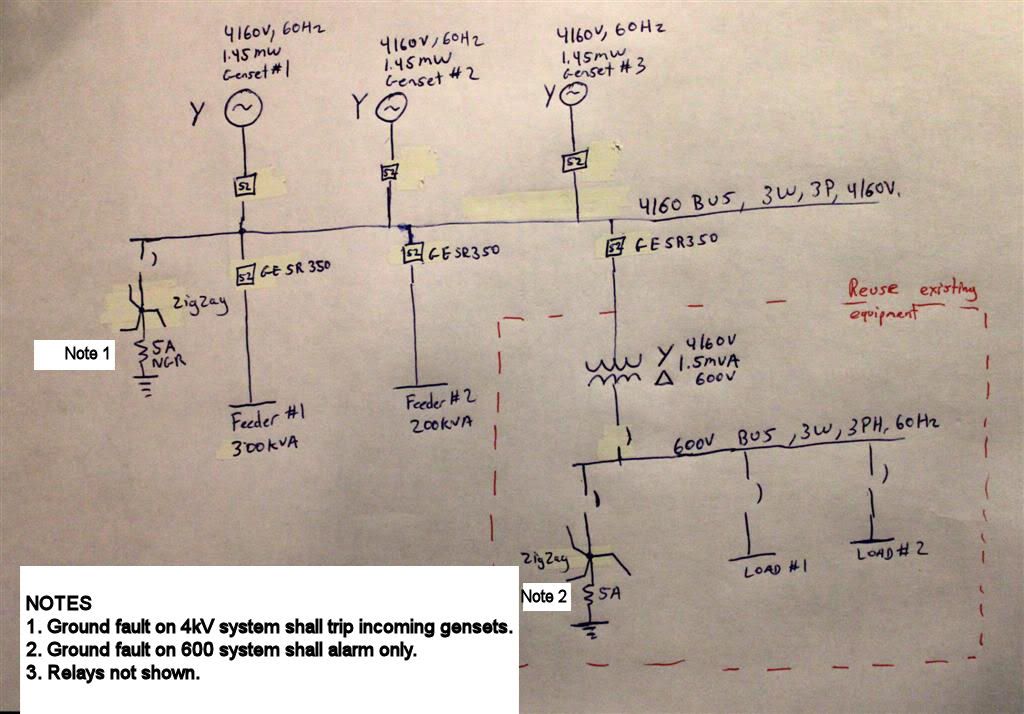Hello,
We have a 1.5MVA XFMR that was used to step up 600V to 4160V for an undergrounded (U/G) tunnel in a remote mining operation. The U/G tunnel has been decommissioned and I would like to reuse this transformer for a 4160/600V step down application. However, I am not familiar with a Wye-Delta configuration and I would like feedback or suggestions to avoid any potential pitfalls or problems that might occur with my idea. I have made a quick hand sketch of the Single Line Diagram I would like to implement:

The transformer shall be reused to step down 4160 to 600V as shown. The transformer comes with a 600V bus and several load side distribution feeders. This equipment is shown within the red dotted square. All 600V equipment shall be 3phase, 3 Wire loads.
The connection from the 4160V bus to the transformer primary shall be with a 100m 4kV cable. Primary protection of the 1.5MVA XFMR is a GE SR-350 relay. Secondary protection shall be a 600V Cutler Hammer Magnum air breaker. All protection shall be dialed to 125% of FLA. Primary and secondary voltage systems are resistant grounded via Zigzag transformers.
I was wondering if I could make use of the is Wye to Delta transformer? I have search through the Eng Tips forum and have read Waross comment’s about the reasons why Wye to Delta transformers should not be used on Overhead lines.
However in this application, I have circuit breakers with a digital relay (no single phase fuse disconnects) and I do not need the Line to neutral voltage. (It shall remain disconnected).
Furthermore, from the book Second Edition, Electrical Machines with Matlab by Turan Gonen:
Just to note that I do prefer using the conventional Delta-wye step down XFMR, but this application reuses an existing piece of decommissioned equipment.
Thanks for the help.
Majesus
We have a 1.5MVA XFMR that was used to step up 600V to 4160V for an undergrounded (U/G) tunnel in a remote mining operation. The U/G tunnel has been decommissioned and I would like to reuse this transformer for a 4160/600V step down application. However, I am not familiar with a Wye-Delta configuration and I would like feedback or suggestions to avoid any potential pitfalls or problems that might occur with my idea. I have made a quick hand sketch of the Single Line Diagram I would like to implement:

The transformer shall be reused to step down 4160 to 600V as shown. The transformer comes with a 600V bus and several load side distribution feeders. This equipment is shown within the red dotted square. All 600V equipment shall be 3phase, 3 Wire loads.
The connection from the 4160V bus to the transformer primary shall be with a 100m 4kV cable. Primary protection of the 1.5MVA XFMR is a GE SR-350 relay. Secondary protection shall be a 600V Cutler Hammer Magnum air breaker. All protection shall be dialed to 125% of FLA. Primary and secondary voltage systems are resistant grounded via Zigzag transformers.
I was wondering if I could make use of the is Wye to Delta transformer? I have search through the Eng Tips forum and have read Waross comment’s about the reasons why Wye to Delta transformers should not be used on Overhead lines.
However in this application, I have circuit breakers with a digital relay (no single phase fuse disconnects) and I do not need the Line to neutral voltage. (It shall remain disconnected).
Furthermore, from the book Second Edition, Electrical Machines with Matlab by Turan Gonen:
In the Wye-Detla connection, there is no problem with third harmonic components in its voltages, since they are aborbed in a circulating current on the delta side. This connection can be used with unbalanced loads.
Just to note that I do prefer using the conventional Delta-wye step down XFMR, but this application reuses an existing piece of decommissioned equipment.
Thanks for the help.
Majesus
